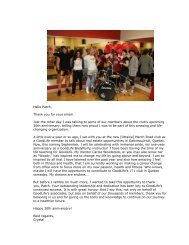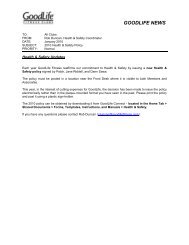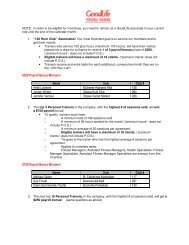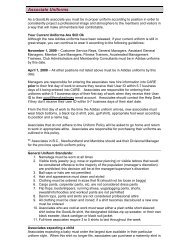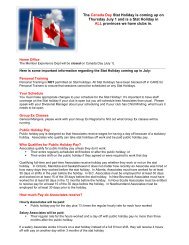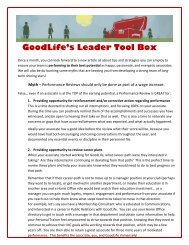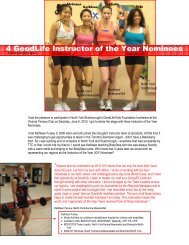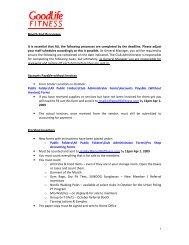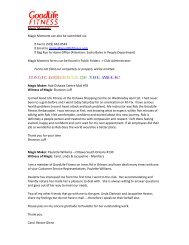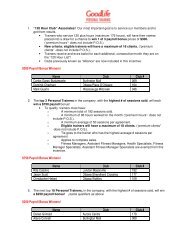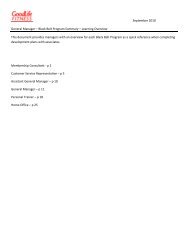Updated Policy and Procedure Handbook - GoodLife Fitness
Updated Policy and Procedure Handbook - GoodLife Fitness
Updated Policy and Procedure Handbook - GoodLife Fitness
- No tags were found...
Create successful ePaper yourself
Turn your PDF publications into a flip-book with our unique Google optimized e-Paper software.
the premises in its employment-related decisions (e.g. if the associate wasinnocent, why would he/she not be prepared to wait for the police to arrive <strong>and</strong>/orotherwise agree to the search voluntarily).Corresponding Wage Increases <strong>and</strong> Position Status Changes tothe Start of a Pay Period[back to top]When managers are switching associates from hourly to salary or from salary to hourly, itmust be done at the start of a pay period instead of part way through a pay period. (seepay period chart below)________________________________________________________________________________________Changing the Hourly/Salary statusIt is very important when an employee changes from hourly to salary or vice versa, that itcorresponds with the start of a pay period!________________________________________________________________________________________Pay Period ChartManagers are responsible for using the Pay Period Chart below to ensure that whenswitching an associate from hourly to salary or vice versa that it occurs at the start of a payperiod instead of part way through a pay period. The left h<strong>and</strong> column shows the payperiods <strong>and</strong> the right h<strong>and</strong> column shows the deposit date.Managers are also responsible for using the Pay Period Chart in order to determine whenan associate should be given a wage increase. The left h<strong>and</strong> column shows the payperiods <strong>and</strong> the right h<strong>and</strong> column shows the deposit date._________________________________________________________________________Switching from Hourly to SalaryWhen associates switch from an hourly position to a salaried position, their salary willbegin at the start of the pay period.For example:If the current pay period was Jan 1st – 14th, paid on Jan 30th, <strong>and</strong> an associate wasswitching from hourly to salary on Monday January 12th, they would be paid their salaryfor the entire pay period Jan 1st – 14th. This associates new salaried position would begiven an ‘effective date’ of Jan 1st (the first day of the pay period).________________________________________________________________________________________Switching from Salary to HourlyThe same applies when associates switch from a salaried position to an hourly position;their salary would remain until the end of the pay period.For example:If the current pay period was Jan 1st – 14th, paid on Jan 30th, <strong>and</strong> an associate switchedfrom a salaried position to an hourly position on Monday January 12th, they would be paidtheir salary for the entire pay period Jan 1st – 14 th . The associates new hourly positionwould be given an ‘effective date’ of Jan 15 th (the first day of the following pay period).Wage ChangesIt is very important that wage increases correspond with the start of a pay period! (see payperiod chart)Managers are responsible to ensure that when giving an associate a wage increase that itoccurs at the start of a pay period instead of part way through a pay period.________________________________________________________________________________________Why the wage increase should begin at the start of a pay periodEnsuring it begins at the start of a pay period makes it easier for the manager tocommunicate to the associate exactly when the increase is effective as well as when theassociate will see the increase on their paycheck. It also allows payroll to calculateappropriately thus ensuring the associate gets their correct increase.Confidential <strong>and</strong> Proprietary Information of <strong>GoodLife</strong> <strong>Fitness</strong> Clubs | V16 October 2009 94



